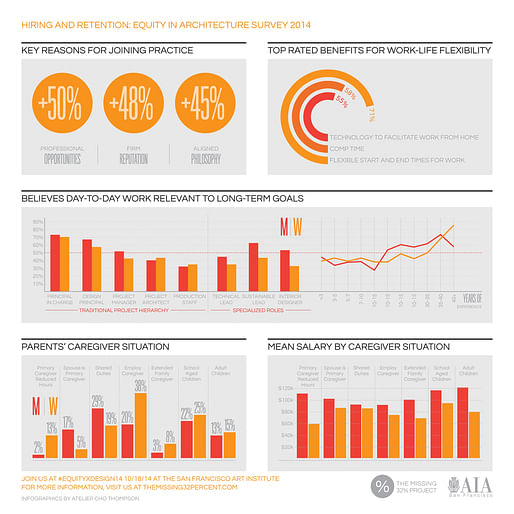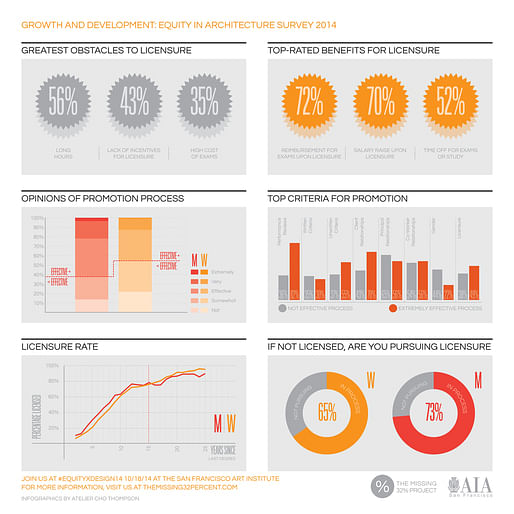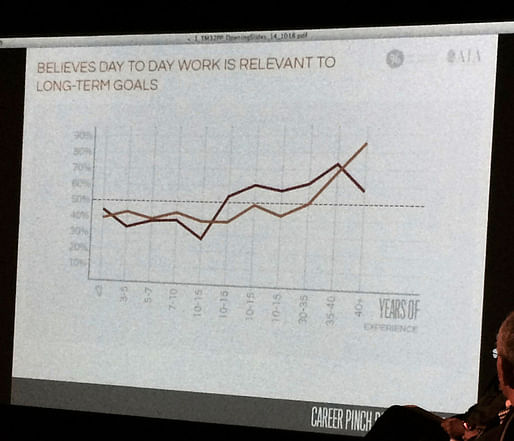
There's a sold-out crowd for the big Missing 32% event today in San Francisco, at the gorgeous San Francisco Art Institute. We're in an intimate auditorium for introductions and recognition of sponsors who collectively shared $34k for the symposium.


8:49 am: Rosa Sheng is explaining how she became involved with Missing 32%: there was a "perfect storm" of Architect Barbie, the Denise Scott Brown petition, Sheryl Sandberg's Lean In--and Rosa was invited to speak at a symposium, drawing her in.

It's no longer a clear-cut issue of outright discrimination, but one of implicit bias, and other subtle and difficult problems.
8:58 am: Emily Grandstaff-Rice of Cambridge 7, president of the Boston Society of Architects, is delivering the keynote. "I cringe when I hear the term woman architect."
What does the public think about when they think of an architect? The audience shouts "Frank Lloyd Wright," "Mies Van Der Rohe," "Frank Gehry"--white men. Women (and minorities, implicitly) are a minority in the profession, but we also don't want these demographic identities to become our entire professional identity.
"What is our value? The value of an architect is measured by more than the square footage of a space...but by the way spaces touch our bodies, hearts, and minds." We change people's lives...and until our profession completely reflects the society it serves, our work will not be done. But when is an architect's work ever done? That is the beauty of this profession.
The panelists introduce themselves:
9:21 am: Mary Breuer runs a recruiting firm for executives and leaders within architecture firms, and she's telling us about 'why now?' Breuer says that her recruits, both male and female, often get turned off by seeing that the entire hiring committee or leadership roster of firms is all or almost all male; she has to convince them that the firm means well and are open to diversity and equity. With robust employment projections from the Bureau of Labor Statistics and DesignIntelligence, this is a big opportunity that Breuer sees for women in the profession.
9:24 am: Cathy Simon, Design Principal at Perkins & Will, introduces herself. She didn't realize that gender was an issue until she entered practice, even though she had no female professors and few female classmates. But she moved to San Francisco in the 1970s, which Simon says was great since the city was so open-minded.
9:31 am: Cary Bernstein runs her own firm and practiced in New York for 6 years before opening her San Francisco office in 1995. She teaches at the California College of the Arts and is a member of the 1% Solution.
9:32 am: Aidan Hughes is leads the North American Planning practice at Arup, which has a Diversity and Inclusion effort. "We're not diverse enough," Hughes says, and adds that it's humbling that just trying to change is still considered notable.
Here are the graphics from the Missing 32% survey results. For the full details, visit their website.








9:35 am: Annelise Pitts, designer at Bohlin Cywinski Jackson, runs through the results of the Missing 32% survey data. She cautions that "we're not here to complain or to blame things on men--we all have awesome male colleagues." Instead, it's about looking for solutions. For example, the survey results found that people aren't asking to do less work, but to have more flexibility in terms of how and where they work.

Note that it's not until 30-35 years of experience that a majority of women in architecture reported that their day to day work is relevant to their long term goals. For men this happens sooner, at 10-15 years-. That's still a long time!

In which roles do people find their day-to-day activities relevant to their long-term goals? There is a big gender gap among sustainability leads and interior designers, with far more men reporting satisfaction in this sense.

New hire salaries are pretty consistent for men and women with less experience, but for those with 15-25 years of experience, male new hires earn quite a bit more.
9:42 am: Pitts: Mary, what do your clients look for in candidates? MB: 1. Fit with firm culture, 2. Ability to convey one's thoughts and opinions concisely, 3. Appropriate enthusiasm, 4. Leadership, 5. Ability to engage personally.
Aidan Hughes discusses implicit bias. "I often have male colleagues who say they don't have bias. I want people to understand that we all have bias and for people to learn to deal with it, instead of thinking we live in a magical world where it's possible to not have bias."
10:20 am: In the 'What's Flex Got to Do With It?' session, speakers are sharing stories about how they've managed their work-life balance in different ways throughout their careers.

10:30 am: In the 'Finding the Right Fit: Strategies for a Targeted Job or Candidate Search' session, panelists are talking about the search process. When you hire, you're filling an immediate need, but staff will often stay for years or decades, so the impact is huge.



11:16 am: Back in the auditorium for the 'Growth & Development' Panel. Saska Dennis-van Dijl is facilitating, and the panelists are: Jennifer Devlin-Herbert, FAIA; Stefee Knudsen, AIA; Damon Leverett, the AIA's Diversity & Emerging Professionals Managing Director; and Michael Armstrong, CEO of NCARB.
DL mentions that among AIA members, women make up 20% of architects. "I hope next year, it'll be the Missing 27%, and the year after that..."
11:21 am: Both men and women who reported that their firm's employee evaluations were important in promotions were also more satisfied with the process. How do men and women experience promotion paths differently?

There's often a price tag, in our salaries, of our career decisions--do I pursue licensure and leadership positions? Do I work in a large or small office?
 Men are somewhat more likely to negotiate their salaries if they find what they're offered to be inadequate, and those who negotiate earn more. "But the real takeaway is that both men and women should negotiate more."
Men are somewhat more likely to negotiate their salaries if they find what they're offered to be inadequate, and those who negotiate earn more. "But the real takeaway is that both men and women should negotiate more."
11:35 am: Michael Armstrong from NCARB. NCARB is focusing on diversity right now--"how we can walk the walk." There are two women leaders in a row right now at AIA, two women leaders in a row at NCARB, (and, I'll add, two women leaders in a row at ACSA!)
"By building flexibility and agility into the path to licensure, that has a natural dividend for women. It's a dividend for everyone...Our board of directors just voted to reduce the total required hours by 1/3 by next June."
"We're also challenging the academy to consider an integrated path to licensure. The three E's (Education, Experience, Exam) remain important but they don't have to be sequential." Examination as a measure of comprehension can follow more closely after or during education. But there's also a great deal of tradition in architecture, and architects will comment that 'it took me a long time and was hard, so it should remain that way.'
"The profession should celebrate licensure. In academy, when I hear that the number of graduates pursuing licensure is low and that faculty members disdain licensure and say it's 'so 20th century'..."
"Our new mantra at NCARB is that we want to facilitate licensure."
11:42 am: Saska Dennis-van Dijl quotes Sheryl Sandberg: "When a woman acts forcefully or competitively, she’s deviating from expected behavior." And “if a woman pushes to get the job done, if she’s highly competent, if she focuses on results rather than on pleasing others, she’s acting like a man—and if she acts like a man, people dislike her."
11:47 am: Damon Leverett: "I started looking at our peers in engineering and STEM, and they have clear ideas about what we should do for girls in school. The critical time for children is ages 8 to 13. What can we do?
1. Often, young people--not just girls, but also minority children--think their mental abilities are fixed. They don't realize that they can improve their mental capabilities, even though they already understand that they can improve at physical things, like tennis.
2. The other thing we can do is provide useful feedback. When you say "great job," young people may think that when they don't hear "great job," it was the opposite and there's nothing they can learn from those situations.
3. Role models.
4. Working with young people on spatial skills.
5. Girls' grades, from age 10-13, are often higher than those of boys, but they may test lower (in standardized tests). So it's not always just about ability, but about context.
11:52 am: Question from the audience: What about the difference between being an architect vs. designer? NCARB talked about making licensure a priority but in industry there's often no perceived difference between an architect and a designer doing architectural work.
SDVD: One of our partners is an unlicensed designer, and that affects us when a client wants a licensed architect on the project.
MA: There is a legal limitation on calling oneself an architect and you can be prosecuted for calling yourself an architect when you're not licensed. These laws are in place to protect the public. "If you're at a place where you think you don't protect the public anymore, then we can drop the whole licensure thing. But we're not there yet."
Question from the audience: When I've taken six of my exams, then lose the credit because the system is changing; and then study for the new exams and lose the credit again; and the exams haven't changed. We're still studying the same errors, learning the same errors in order to pass the exam. It has taken me a lifetime to pass my exams. What about that?
MA: This is the rolling clock, when passing grades on exams last for five years but then expire. There are extensions for military duty, childbirth, serious medical conditions and other reasons.
LUNCH TIME!
Thanks for reading! I'll live blog again in the afternoon in a new post.
Lian
The Association of Collegiate Schools of Architecture is a nonprofit membership organization, founded in 1912 to advance the quality of architectural education. Our members are over 250 schools, including all accredited programs in the USA and Canada, schools seeking accreditation, and non-accredited and international programs--representing over 40,000 architecture faculty and students.
3 Comments
Lian, great job, it seems like this symposium answers more questions, and marks a stark contrast when it comes to gender differences in the profession. Thanks for posting this.
Thanks, b3tadine[sutures]! It was great, and the survey results they were sharing are pretty informative too.
I'm surprised only about a third of men or women have tried to negotiate an unsatisfactory salary offer! Are most people satisfied with the first offer - or resigned to taking it? I can understand this for a first job, but the survey covered a wide range of experience levels. But good to note that of those who negotiate, men and women are about equally successful.
Also interesting to see how quickly young employees lose the desire to open a firm: 60% at less than 3 years exp to 15% by 10 years. Goes to show that students don't come out with a good sense of the reality of the profession.
Block this user
Are you sure you want to block this user and hide all related comments throughout the site?
Archinect
This is your first comment on Archinect. Your comment will be visible once approved.